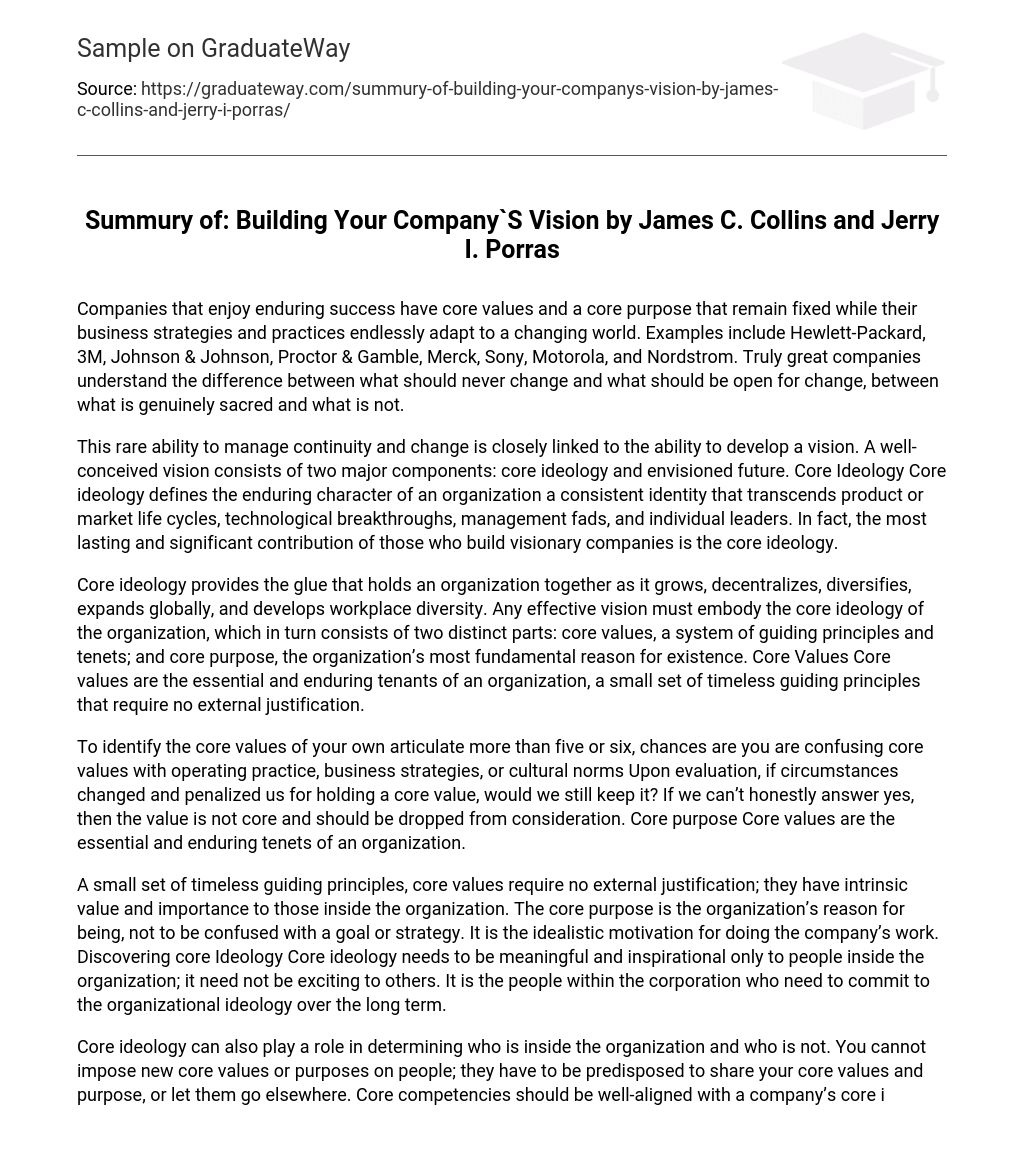Companies that enjoy enduring success have core values and a core purpose that remain fixed while their business strategies and practices endlessly adapt to a changing world. Examples include Hewlett-Packard, 3M, Johnson & Johnson, Proctor & Gamble, Merck, Sony, Motorola, and Nordstrom. Truly great companies understand the difference between what should never change and what should be open for change, between what is genuinely sacred and what is not.
This rare ability to manage continuity and change is closely linked to the ability to develop a vision. A well-conceived vision consists of two major components: core ideology and envisioned future. Core Ideology Core ideology defines the enduring character of an organization a consistent identity that transcends product or market life cycles, technological breakthroughs, management fads, and individual leaders. In fact, the most lasting and significant contribution of those who build visionary companies is the core ideology.
Core ideology provides the glue that holds an organization together as it grows, decentralizes, diversifies, expands globally, and develops workplace diversity. Any effective vision must embody the core ideology of the organization, which in turn consists of two distinct parts: core values, a system of guiding principles and tenets; and core purpose, the organization’s most fundamental reason for existence. Core Values Core values are the essential and enduring tenants of an organization, a small set of timeless guiding principles that require no external justification.
To identify the core values of your own articulate more than five or six, chances are you are confusing core values with operating practice, business strategies, or cultural norms Upon evaluation, if circumstances changed and penalized us for holding a core value, would we still keep it? If we can’t honestly answer yes, then the value is not core and should be dropped from consideration. Core purpose Core values are the essential and enduring tenets of an organization.
A small set of timeless guiding principles, core values require no external justification; they have intrinsic value and importance to those inside the organization. The core purpose is the organization’s reason for being, not to be confused with a goal or strategy. It is the idealistic motivation for doing the company’s work. Discovering core Ideology Core ideology needs to be meaningful and inspirational only to people inside the organization; it need not be exciting to others. It is the people within the corporation who need to commit to the organizational ideology over the long term.
Core ideology can also play a role in determining who is inside the organization and who is not. You cannot impose new core values or purposes on people; they have to be predisposed to share your core values and purpose, or let them go elsewhere. Core competencies should be well-aligned with a company’s core ideology and are often rooted it in; but they are not the same thing. Core competence is a strategic concept that defines your organization’s capabilities, what you are particularly good at– whereas core ideology captures what you stand for and why you exist.
Envisioned future An envisioned future, the second component of an effective vision, has two elements: 1. Big, Hairy, Audacious Goals (BHAGs) are ambitious plans that rev up the entire organization. They typically require 10 to 30 years’ work to complete. A company must have a BHAG (pronounced Bee-hag), a “big, hairy audacious goal” a clear and compelling unifying focal point of effort and a catalyst for team spirit. It has a finish line, so organization can know when it has achieved the goal.
A BHAG should not be a sure bet — it will have perhaps only a 50% to 70% probability of success but the organization must believe that it can reach the goal anyway. 2. Vivid descriptions paint a picture of what it will be like to achieve the BHAGs. Vivid descriptions are vibrant, engaging and specific descriptions of what it will be like to achieve the BHAG. Think of it as translating the vision from words to pictures. A direct link to the fundamental dynamic of visionary companies: preserve the core and stimulate progress. Building a visionary organization is 1% vision and 99% alignment.





